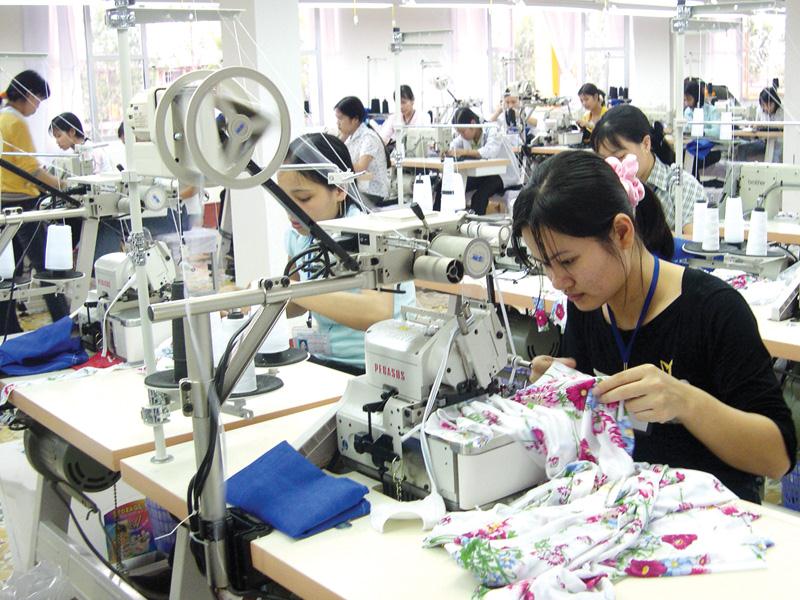


Textiles maintain FDI attraction
19-03-2018
Concerns about FDI inflows into Vietnam's textile and apparel industry face a deceleration soon after the United States announced its withdrawal from the Trans-Pacific Partnership (TPP) agreement in January 2017, to date. had the answer.
Textile still heat
After a period of rapid development in terms of scale, production capacity exceeded $ 35 billion, along with Vietnam's participation in many bilateral and multilateral free trade agreements (FTAs). Our country with foreign investors is still very strong.

The attraction of FDI into the textile and garment industry is still maintained. Photo: Fabi Secret Vietnam Co., a textile and garment FDI company from Taiwan.
In the first two months of 2018, some FDI projects producing materials and accessories for the textile and apparel industry continue to be approved by localities. Just before the Lunar New Year in 2018, Nam Dinh province handed over a certificate of investment to Nam Dinh Ramatex Textile and Garment Factory for Herberton (Singapore) Ltd.
Ramatex Textile and Garment Factory has a total investment of VND1,818 billion (US $ 80 million), specializing in the production of knitted fabrics, knitted fabrics and other non-woven fabrics; Garment (except leather and fur garments), located in Bao Minh Industrial Park, Nam Dinh province. Expected, the factory will be completed and put into operation in 2019 with a capacity of 25,000 tons of fabrics, 15 million costumes per year, creating jobs for about 3,000 workers.
Ramatex is not a foreign name in the Asian apparel industry. The manufacturer has expanded its operations throughout Asia with three textile factories and 13 garment factories in Singapore, Malaysia, Cambodia and China.
Another project of producing materials and auxiliary materials of Japanese investors was also granted investment certificate in February, 2018, which is Ha Nam YKK Factory Project, specialized in producing all kinds of zippers, related, raw materials for the garment industry with the production scale 420 million products per year. This project has total investment capital of US $ 80 million, in Dong Van III Industrial Zone, Duy Tien District, Ha Nam Province.
As a manufacturer of zippers, with a large market share in the world, YKK officially operated in Vietnam in 1998, specializing in manufacturing zippers for clothing, shoes, suitcases, plastic buckles for helmets and a number of other auxiliary products. The manufacturer has chosen Vietnam as the new factory to increase its output to the global market.
Export benefits help "pull" foreign capital
Luong Hoang Thai, Director General of the Department for Multilateral Trade Policy (Ministry of Industry and Trade), member of the negotiating delegation to Vietnam's Comprehensive Partnership for Trans-Pacific Partnership (CPTPP) affirmed that export benefits exports continue to accompany the opportunity to attract FDI in the textile and garment industry when the CPTPP.
In the past, some observers expected the sector to benefit from FDI, including textiles, footwear and food processing. To date, this statement is still true.
In fact, the wave of FDI in the textile and garment industry in Vietnam has increased strongly since our country joined the TPP negotiations, but after the US withdrawal from the TPP, FDI inflows have not suddenly increased, even more than 1 In recent years, the number of newly issued projects has been gradually reduced. In spite of this, textile and garment still has more than US $ 750 million in capital, mainly due to the increase of capital. Thus, although the number of projects is not much, but the amount of capital brought to Vietnam investors "massive".
Sharing the same view on the opportunities of the textile industry, Vu Duc Giang, Chairman of the Vietnam Textile and Apparel Association (VITAS), said that the industry will continue to be attractive to foreign investors. 2040.
The basis for this assessment, according to Jiang's analysis, is that, as foreign investors have invested in the textile and apparel industry, they will attract more investors to invest. to Vietnam.
Not only is CPTPP more motivated, Vietnam's textile and apparel industry is waiting for new capital flows from the EU, one of the key export markets for Vietnamese textiles and garments with the scale of over $ 4 billion. Vietnam - EU free trade agreement (EVFTA) will take effect later this year.
Nguyen Xuan Duong, Chairman of Hung Yen Garment Joint Stock Corporation, an enterprise that has a high proportion of textiles and garments exported to the US and the EU, said that although the US did not sign the CPTPP, this was still the market. Vietnam's most important textile and garment export. In addition, with the need to perfect the supply chain in the manufacturing industry, Vietnam garment and textile still converge conditions for FDI enterprises to choose investment.
"With large-scale FTAs ​​entering into implementation, especially with the CPTPP, import tariffs on Vietnamese industrial goods will fall to 0% in line with the roadmap. Although, export benefits still stimulate investors to invest. For example, the trend of fiber production for export has been formed, as Vietnam has a large fiber export market to Turkey, China ... and FDI inflows to the yarn industry can continue to increase. "He said.
Also attractive to pull foreign capital, which also means that the production and export capacity of Vietnam garment has many opportunities to expand and develop in the next period.
Source: http://agtek.org.vn